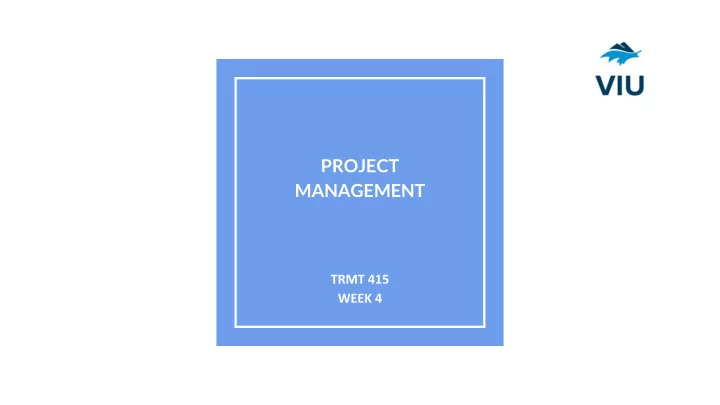

PROJECT MANAGEMENT
Outcomes for Week 4 1. Finalize content delivery for the Planning Phase 2. Explore the final two stages of a project 3. Assign and review requires for our first case study
Class Discussion ● Assignment of Case 1 & SBAR Discussion ● Question: ○ In thinking about weeks 1-4 of TRMT 415, if you were the Project Manager for BAE Systems, what might you have done differently in the project initiation and planning phases? If nothing, explain. ● Deadline Discussion ● Pre-Mortem
Project Management Recap Weeks 1,2,3
Let’s Recap Weeks 1, 2 & 3 A project life cycle typically has 4 major phases: ● Initiation ○ Planning ○ Implementation ○ Monitor/Controls ■ Closure ○
Project Life Cycle: Initiation Phase The first phase explores the project concept. ● Scope is defined during this phase. ● Feasibility studies are made in order to identify if there is a ● business need and justification to pursue the project. Project charter is developed for approval. ● This is the phase that the project team is assembled and the ● project manager is identified.
Project Life Cycle: Initiation Phase Complex project needs coordination of: Multiple people ● Multiple resources (labs, equipment, etc.) ● Multiple tasks – some must precede others ● Multiple decision points – approvals ● Phased expenditure of funds ● Matching of people/resources to tasks ●
Managing Constraints
Initiation Phase: Critical Takeaways Keys to Phase 1 ● Clarity and Alignment on the Project ○ What does success look like? ■ What are the expected deliverables required by stakeholders? ■ Establish a communication channel to manage scope ■ Clarity and Alignment People ○ Roles ■ Accountabilities ■ Communication Projects ■ Clarity and Alignment Agreements and/or Project Charters ■ Risk Management ○ Critical thinking of the risks that will impact the project planning phase ■ Structured assessment and strategy development ■
Planning Phase
Project Success…. Project Management Success Factors ● Stakeholder involvement ○ Executive management support ○ Clear statement of requirements ○ Proper planning ○ Realistic expectations ○ Smaller project milestones ○ Competent staff ○ Ownership ○ Clear vision and objectives ○ Hard working and focused staff ○
Planning Phase
Project Life Cycle: Planning Phase Step 1: Recognizing the need ● Listen to the customer’s needs. Dissatisfaction with an existing ○ situation/product? Needs to accomplish new functionality? What is the ultimate purpose of the project? Step 2: Defining the problem ● Translate needs to a problem statement: ○ Objectives – A quantifiable set of performance expectations ■
Project Life Cycle: Planning Phase Step 3: Planning the project ● How do we do it? How do we organize ourselves? How do we get from here ○ to there? WBS ■ Project management and controls ■ Step 4: Gathering information ● Solutions to similar problems? ○ Background research? Patents? ○ This could be an empty set for some problems ○
Project Life Cycle: Planning Phase Step 5: Conceptualizing alternative approaches ● “Concept generation” ○ Generate wide range of design options ○ Suspend judgment, anything goes, let creativity run wild ○ Step 6: Evaluating the alternatives ● Use analysis to quantify expected performance of design options ○ Predict cost of each alternative ○
Project Life Cycle: Planning Phase Step 7: Selecting the best alternative ● Develop criteria to select “best” alternative (must match customer’s needs ○ and input) Create a formal selection process (decision matrix) ○ Step 8: Communicating the design ● Step 9: Implementing the preferred design ● Final (detailed) design ○ Construction and test ○
Planning Phase: Tools for Managers
Common Tools for Project Planning ● Work Breakdown Structure (WBS) ● Critical Path Method (CPM) ● Program Evaluation & Review Technique (PERT) ● Gannt Chart ● Logical Framework Analysis (LFA)
Planning Phase: Work Breakdown Structure ● A “System” (and the design activities that go with it) is “broken down” into sub-systems. ● The breakdown is arbitrary, yet it must follow some logic when it comes to the design activities ● The general criterion is to select sub-systems with clearly defined interfaces (tracking concern – most problems come from “unmatched” interface issues) ● The resulting set of sub-systems define a set of design activities or “Work Breakdown Structure” (WBS)
Planning Phase: WBS ● Must be clear and simple (tree structure) ● Must follow the structure of major sub-systems in a logical way ● Once created it cannot change for the duration of the project (yet it needs some flexibility to accommodate the unexpected)
WBS Example ● Level 1 “Prepare and eat a meal” ● Level 2 Break it down ● Preparation • Boil soup • Boil rice • Boil peas • Brown chicken • Prepare sauce • Bake chicken, rice and sauce • Open wine and let it breathe ● Eating • Eat soup • Eat entrée ● Level 3 Incorporate into a schedule (timing element)
See you next week
Recommend
More recommend